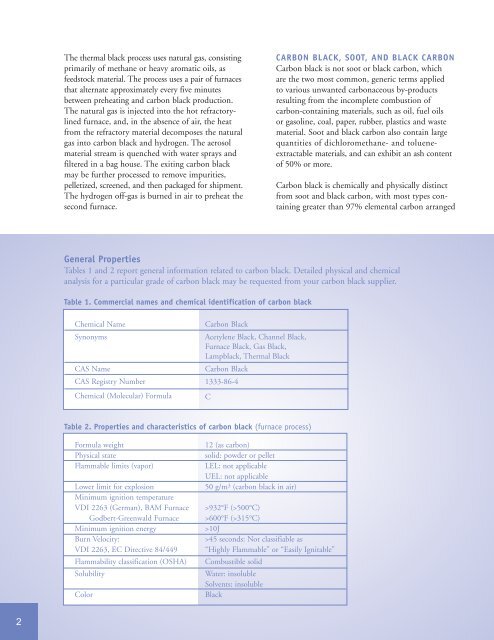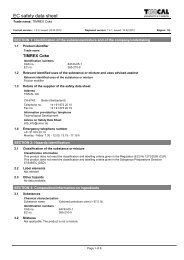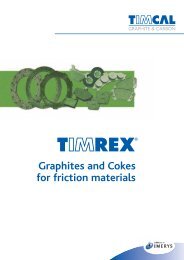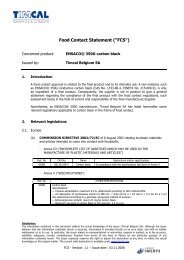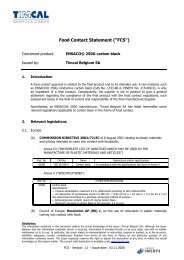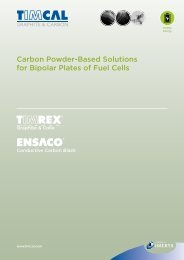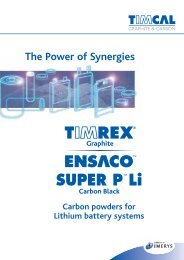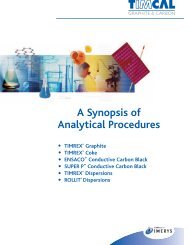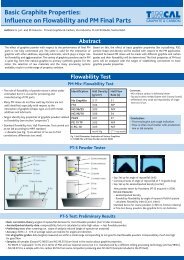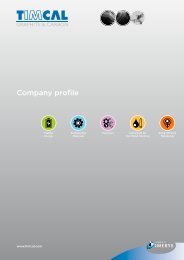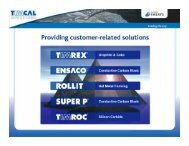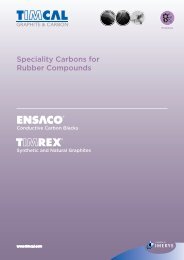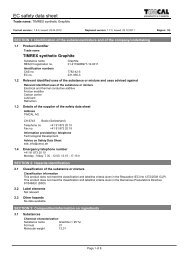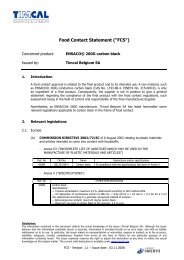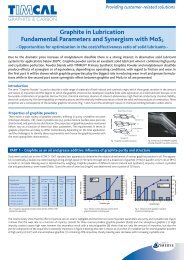Carbon Black Users Guide - Timcal
Carbon Black Users Guide - Timcal
Carbon Black Users Guide - Timcal
You also want an ePaper? Increase the reach of your titles
YUMPU automatically turns print PDFs into web optimized ePapers that Google loves.
The thermal black process uses natural gas, consistingprimarily of methane or heavy aromatic oils, asfeedstock material. The process uses a pair of furnacesthat alternate approximately every five minutesbetween preheating and carbon black production.The natural gas is injected into the hot refractorylinedfurnace, and, in the absence of air, the heatfrom the refractory material decomposes the naturalgas into carbon black and hydrogen. The aerosolmaterial stream is quenched with water sprays andfiltered in a bag house. The exiting carbon blackmay be further processed to remove impurities,pelletized, screened, and then packaged for shipment.The hydrogen off-gas is burned in air to preheat thesecond furnace.CARBON BLACK, SOOT, AND BLACK CARBON<strong>Carbon</strong> black is not soot or black carbon, whichare the two most common, generic terms appliedto various unwanted carbonaceous by-productsresulting from the incomplete combustion ofcarbon-containing materials, such as oil, fuel oilsor gasoline, coal, paper, rubber, plastics and wastematerial. Soot and black carbon also contain largequantities of dichloromethane- and tolueneextractablematerials, and can exhibit an ash contentof 50% or more.<strong>Carbon</strong> black is chemically and physically distinctfrom soot and black carbon, with most types containinggreater than 97% elemental carbon arrangedGeneral PropertiesTables 1 and 2 report general information related to carbon black. Detailed physical and chemicalanalysis for a particular grade of carbon black may be requested from your carbon black supplier.Table 1. Commercial names and chemical identification of carbon blackChemical NameSynonymsCAS NameCAS Registry NumberChemical (Molecular) Formula<strong>Carbon</strong> <strong>Black</strong>Acetylene <strong>Black</strong>, Channel <strong>Black</strong>,Furnace <strong>Black</strong>, Gas <strong>Black</strong>,Lampblack, Thermal <strong>Black</strong><strong>Carbon</strong> <strong>Black</strong>1333-86-4CTable 2. Properties and characteristics of carbon black (furnace process)Formula weightPhysical stateFlammable limits (vapor)Lower limit for explosionMinimum ignition temperatureVDI 2263 (German), BAM FurnaceGodbert-Greenwald FurnaceMinimum ignition energyBurn Velocity:VDI 2263, EC Directive 84/449Flammability classification (OSHA)SolubilityColor12 (as carbon)solid: powder or pelletLEL: not applicableUEL: not applicable50 g/m 3 (carbon black in air)>932°F (>500°C)>600°F (>315°C)>10J>45 seconds: Not classifiable as“Highly Flammable” or “Easily Ignitable”Combustible solidWater: insolubleSolvents: insoluble<strong>Black</strong>2


